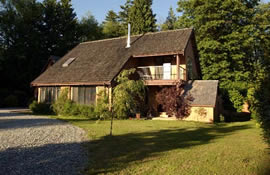

| August 27, 2004 | science beat | | lab a-z index | lab home |
 |
 |
||
|
|||
| Cool Colors, Cool Roofs |
| Contact: Allan Chen, a_chen@lbl.gov |
| Roofs, and the rainbow of colors used in roofing materials, are getting cooler and cooler, thanks to research by Berkeley Lab's Environmental Energy Technologies Division (EETD). The cooler roofs get, the more energy and money they save. A new program in cool materials will soon result in the first cool shingle for residential roofs becoming available on the market. Since the mid-1980s, Berkeley Lab researchers have studied the effects of increasing the solar reflectance of roofs. "Cool" roofs, which reflect more of the sun's radiation than conventional roofs, keep houses and other structures cooler, lower their air-conditioning energy use, and reduce the "urban heat island effect," in which air temperatures in urban areas are higher than surrounding rural areas. 
Home owners whose houses have pitched roofs prefer darker colors for roofing. Since dark surfaces are better heat absorbers, traditional cool roofs are white. Berkeley Lab research has demonstrated that raising the solar reflectance of a roof from about 20 percent (dark gray) to about 55 percent (weathered white) can reduce cooling energy use by 20 percent. Flat-roofed commercial buildings are often fitted with white roofs, but U.S. homeowners typically demand nonwhite roofs. Cool-colored, nonwhite roofs meet that need. It is possible to create a nonwhite cool roof by using colorants or pigments that reflect the invisible, near-infrared radiation that accounts for over half of the energy in sunlight. "Our research estimates that the potential net energy savings in the U.S. achievable by applying white roofs to commercial buildings and cool-colored roofs to houses is more than $750 million per year," says Hashem Akbari, an EETD researcher and head of the Heat Island Group. The Heat Island Group's research has shown that, regionally, widespread application of cool roofs can reduce ambient air temperatures and retard smog formation. Cool roofs can also reduce peak electrical demand in the summer, which helps reduce strain on the aging electricity grid when relief is most needed. Lower temperatures on the roofs may also increase the life of a roof, according to preliminary research by the group. Thanks to the work of Akbari's team, the roofing industry in recent years has adopted voluntary industry standards for measuring the reflectance of roofing materials and has set up the Cool Roof Rating Council to develop labels that inform buyers about the relative coolness of various products used in roofing — that is, their ability to reflect solar energy and release heat through thermal radiation. The building-materials industry has brought a number of products to the marketplace that help increase the reflectance of roofs, including elastomeric coatings, single-ply membranes, tiles, and metal roofing. And the Environmental Protection Agency's Energy Star program certifies cool roof products with its voluntary labeling; EPA maintains a web-based guide to Energy Star roofing products. However, technical barriers to getting cool roofs on homes still remain. Existing white and nonwhite cool coatings are fine for the low-slope roofs of commercial and industrial buildings and apartment structures, where white is acceptable. But on the high-slope roofs of single-family homes, which can been seen from the street, the market is dominated by colorful shingles, tiles, metal products, and wood shakes. Most homeowners don't want white roofs. Asphalt shingles account for 47 percent of the roofing market for residences in the western states, according to industry sources. Cool-colored roofing materials in a variety of styles, resembling those in this digital image by Tom Marlin of Marlin Studios (www.marlinstudios.com), will soon be on the way for the residential market. To bring cool roofs to the high-slope residential market, research was needed to identify cool color pigments and a different way of manufacturing asphalt shingles. Thanks to a research project funded by the California Energy Commission and the U.S. Department of Energy, consumers will soon see a variety of new cool-colored roofing products to help them save energy and increase the comfort of their homes. Berkeley Lab is working with Oak Ridge National Laboratory, two pigment manufacturers, and ten roofing manufacturers who collectively produce about 90 percent of the residential roofing products in the United States. The industrial partners are 3M, American Roof Tile Coating, BASF, Custom-Bilt Metals, Elk Manufacturing, Ferro, GAF, Hanson Roof Tile, ISP Minerals, MCA, Monier Lifetile, and Shepherd Color Company. "Most commercially available roof shingles are optically dark," says Akbari. "Their solar reflectances range from 5 to 25 percent, depending on color. Even the majority of nominally 'white' roof shingles are grayish, and have a solar reflectance of about 25 percent, which is much lower than the 70 percent solar reflectance of white tiles or white metal panels. Since many homeowners prefer nonwhite roofs, we are working to develop cool-colored roof products." Cool Colors, Cool Roofs, part 2 |
| Top |